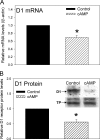The extracellular cAMP-adenosine pathway regulates expression of renal D1 dopamine receptors in diabetic rats
- PMID: 21803776
- PMCID: PMC3173236
- DOI: 10.1074/jbc.M111.268136
The extracellular cAMP-adenosine pathway regulates expression of renal D1 dopamine receptors in diabetic rats
Abstract
Activation of D1 dopamine receptors expressed in the kidneys promotes the excretion of sodium and regulates sodium levels during increases in dietary sodium intake. A decrease in the expression or function of D1 receptors results in increased sodium retention which can potentially lead to the development of hypertension. Studies have shown that in the absence of functional D1 receptors, in null mice, the systolic, diastolic, and mean arterial pressures are higher. Previous studies have shown that the expression and function of D1 receptors in the kidneys are decreased in animal models of diabetes. The mechanisms that down-regulate the expression of renal D1 receptor gene in diabetes are not well understood. Using primary renal cells and acutely isolated kidneys from the streptozotocin-induced rat diabetic model, we demonstrate that the renal D1 receptor expression is down-regulated by the extracellular cAMP-adenosine pathway in vitro and in vivo. In cultures of primary renal cells, a 3 mm, 60-h cAMP treatment down-regulated the expression of D1 receptors. In vivo, we determined that the plasma and urine cAMP levels as well as the expression of 5'-ectonucleotidase, tissue-nonspecific alkaline phosphatase, and adenosine A2a receptors are significantly increased in diabetic rats. Inhibitors of 5'-ectonucleotidase and tissue-nonspecific alkaline phosphatase, α,β-methyleneadenosine 5'-diphosphate, and levamisole, respectively, blocked the down-regulation of D1 receptors in the primary renal cells and in the kidney of diabetic animals. The results suggest that inhibitors of the extracellular cAMP-adenosine pathway reverse the down-regulation of renal D1 receptor in diabetes.
Figures










Similar articles
-
Extracellular cAMP inhibits D1 dopamine receptor expression in CAD catecholaminergic cells via A2a adenosine receptors.J Neurochem. 2007 May;101(3):619-31. doi: 10.1111/j.1471-4159.2006.04388.x. Epub 2007 Jan 24. J Neurochem. 2007. PMID: 17254022
-
Elevation of cAMP is required for down-regulation, but not agonist-induced desensitization, of endogenous dopamine D1 receptors in opossum kidney cells. Studies in cells that stably express a rat cAMP phosphodiesterase (rPDE3) cDNA.J Biol Chem. 1993 Jul 15;268(20):14757-63. J Biol Chem. 1993. PMID: 8392059
-
Activation of adenosine A2A and dopamine D1 receptors stimulates cyclic AMP-dependent phosphorylation of DARPP-32 in distinct populations of striatal projection neurons.Neuroscience. 1998 May;84(1):223-8. doi: 10.1016/s0306-4522(97)00510-1. Neuroscience. 1998. PMID: 9522376
-
The extracellular cyclic AMP-adenosine pathway in renal physiology.Annu Rev Physiol. 2004;66:571-99. doi: 10.1146/annurev.physiol.66.032102.111604. Annu Rev Physiol. 2004. PMID: 14977414 Review.
-
Dopamine receptor signaling defects in spontaneous hypertension.Am J Hypertens. 1996 Apr;9(4 Pt 1):400-5. doi: 10.1016/0895-7061(95)00351-7. Am J Hypertens. 1996. PMID: 8722444 Review.
Cited by
-
The 2',3'-cAMP-adenosine pathway.Am J Physiol Renal Physiol. 2011 Dec;301(6):F1160-7. doi: 10.1152/ajprenal.00450.2011. Epub 2011 Sep 21. Am J Physiol Renal Physiol. 2011. PMID: 21937608 Free PMC article. Review.
-
Cyclic nucleotide permeability through unopposed connexin hemichannels.Front Pharmacol. 2013 Jun 6;4:75. doi: 10.3389/fphar.2013.00075. eCollection 2013. Front Pharmacol. 2013. PMID: 23760880 Free PMC article.
-
Dopamine Receptors and the Kidney: An Overview of Health- and Pharmacological-Targeted Implications.Biomolecules. 2021 Feb 10;11(2):254. doi: 10.3390/biom11020254. Biomolecules. 2021. PMID: 33578816 Free PMC article. Review.
-
Purines: forgotten mediators in traumatic brain injury.J Neurochem. 2016 Apr;137(2):142-53. doi: 10.1111/jnc.13551. Epub 2016 Feb 25. J Neurochem. 2016. PMID: 26809224 Free PMC article. Review.
-
Interactive roles of CD73 and tissue nonspecific alkaline phosphatase in the renal vascular metabolism of 5'-AMP.Am J Physiol Renal Physiol. 2014 Sep 15;307(6):F680-5. doi: 10.1152/ajprenal.00312.2014. Epub 2014 Jul 2. Am J Physiol Renal Physiol. 2014. PMID: 24990899 Free PMC article.
References
Publication types
MeSH terms
Substances
LinkOut - more resources
Full Text Sources

